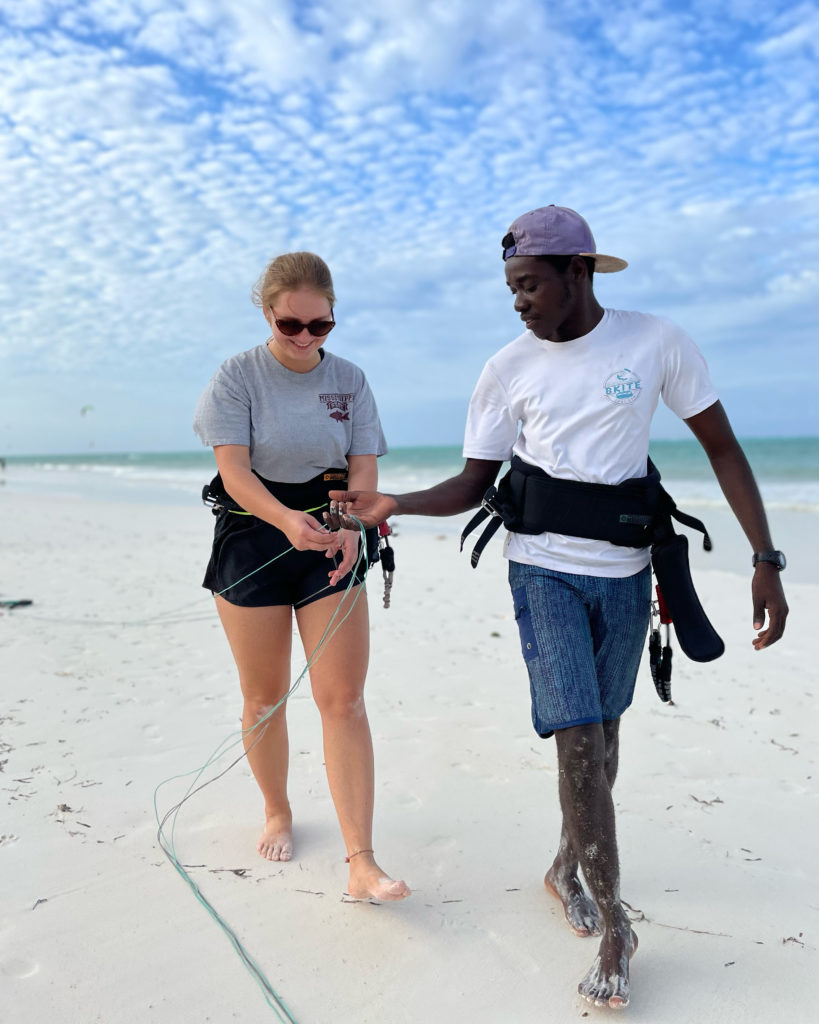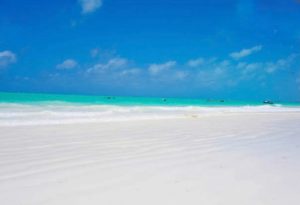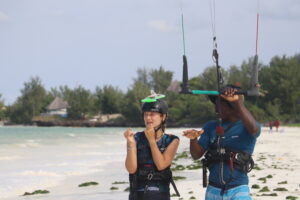Discover Kite Surfing at Paje Beach Zanzibar

1.1. Location and geography
Paje Beach is one of the best kitesurfing destinations, is a stunning stretch of white sand on the southeast coast of Zanzibar, an island off the coast of Tanzania. It’s about 45 minutes from Stone Town, the main city. The beach is long and wide, with shallow, turquoise waters that seem to go on forever.

1.2. Climate and weather conditions
Discover Kite Surfing at Paje Beach and enjoys a tropical climate with warm temperatures year-round. The best time for kite surfing is from June to September and December to March when the winds are strongest. It can get pretty hot during the day, so don’t forget your sunscreen!
1.3. Local culture and community
The people of Paje are mostly fishermen and seaweed farmers. They’re friendly and welcoming to visitors. You’ll often see locals going about their daily routines on the beach, which adds to the authentic charm of the place.
2. Kite Surfing Basics
2.1. What is kite surfing?
Kite surfing is a water sport that combines elements of surfing, windsurfing, and paragliding. You stand on a board and use a large kite to pull you across the water. It’s exciting and fun once you get the hang of it!
2.2. Essential equipment
To kite surf, you’ll need:
-
A kite
-
A board
-
A harness
-
A bar and lines
-
A helmet (for beginners)
-
A impact vest
Most schools provide all this equipment when you’re learning.
2.3. Safety considerations
Kite surfing can be dangerous if you’re not careful. Always check the weather conditions, never kite alone, and make sure you understand how to use your safety release system. It’s also a good idea to take lessons from a certified instructor before going out on your own.
3. Why Paje Beach is Ideal for Kite Surfing
3.1. Wind conditions and seasons
Paje Beach has consistent wind conditions that are perfect for kite surfing. The best wind seasons in zanzibar comes during the kusi (southeast monsoon) from June to September, and the kaskazi (northeast monsoon) from December to March.
3.2. Water characteristics
The water at Paje is warm and crystal clear. At low tide, the water is shallow for a long way out, which is great for beginners. During high tide, there’s more than enough depth for advanced tricks.
3.3. Beach layout and accessibility
The beach is wide and long, giving you plenty of space to set up and launch your kite. There are no obstacles in the water, which makes it safer for everyone. It’s easy to get to Paje from most parts of Zanzibar, and there are plenty of places to stay nearby.
4. Learning to Kite Surf at Paje
4.1. Kite surfing schools and instructors
There are several kite surfing schools at Paje Beach. They all have experienced instructors who can teach you the basics and help you improve your skills. Some popular schools include Bkite zanzibar

4.2. Beginner-friendly areas
The shallow waters and wide beach make Kite Surfing at Paje Beach excellent spot for beginners. Most schools have designated areas where they teach, away from more experienced kiters.
4.3. Progression and skill development
As you get better, you can move to deeper waters and try more advanced techniques. Many people find they can go from complete beginner to riding independently within a week or two of daily practice.
5. Best Spots for Experienced Kite Surfers
5.1. Advanced kite surfing locations
For those who’ve mastered the basics, the area in front of Paje village offers some great conditions for jumping and tricks. When the tide is high, you can kite further out for some nice waves.
5.2. Challenging conditions and features
During certain times of the year, especially July and August, the wind can get quite strong, providing exciting challenges for advanced kiters. There are also some areas with choppier water for those looking to practice in more difficult conditions.
5.3. Local kite surfing community
Paje has a friendly community of local and expat kite surfers. They often organize informal meetups and competitions. It’s a great way to make friends and learn new tricks from other experienced kiters.
6. Beyond Kite Surfing: Other Activities at Paje Beach
6.1. Snorkeling and diving
When the wind isn’t right for kiting, you can explore the underwater world. There are beautiful coral reefs not far from shore, teeming with colorful fish and sea life.
6.2. Beach relaxation and sunbathing
Paje’s white sand beaches are perfect for lounging and soaking up the sun. There are plenty of beach bars where you can relax with a cool drink and watch the kite surfers.

6.3. Local cuisine and dining options
Don’t miss out on trying the local Zanzibari food. Fresh seafood is a specialty, often prepared with aromatic spices. There are also several restaurants offering international cuisine if you’re craving something familiar.
7. Accommodation at paje Options
7.1. Beachfront resorts
For those who want luxury, there are several high-end resorts right on the beach. These often have their own restaurants, pools, and sometimes even kite surfing schools.

7.2. Budget-friendly guesthouses
If you’re watching your wallet, there are many affordable guesthouses in Paje village. They’re usually simple but clean and comfortable, and often just a short walk from the beach.
7.3. Eco-lodges and sustainable stays
For the environmentally conscious traveler, Paje has a few eco-lodges that focus on sustainability. These places often use solar power, recycle water, and support local community projects.
Summary
Paje Beach in Zanzibar is a kite surfer’s paradise. With its consistent winds, beautiful waters, and long, wide beach, it’s perfect for both beginners and experienced kiters. There’s a friendly community, plenty of schools for learning, and lots to do when you’re not on the water. Whether you’re looking for accommodation at paje on luxurious resort or a budget-friendly stay, Paje has accommodation options for everyone. So why not give kite surfing a try on this beautiful Zanzibar beach?
FAQs
-
When is the best time to Kite Surfing at Paje Beach?
The best times are from June to September and December to March when the winds are strongest.
-
Do I need to bring my own kite surfing equipment?
Most schools provide equipment for lessons. If you’re experienced, you can bring your own or rent from local shops.
-
How long does it take to learn kite surfing?
Most people can learn the basics and start riding independently within a week or two of daily practice.
-
Kite Surfing at Paje Beach is suitable for beginners?
Yes, the shallow waters and wide beach make it an excellent spot for beginners.
-
What else can I do in Paje besides kite surfing?
You can go snorkeling, relax on the beach, try local cuisine, and explore the village.
